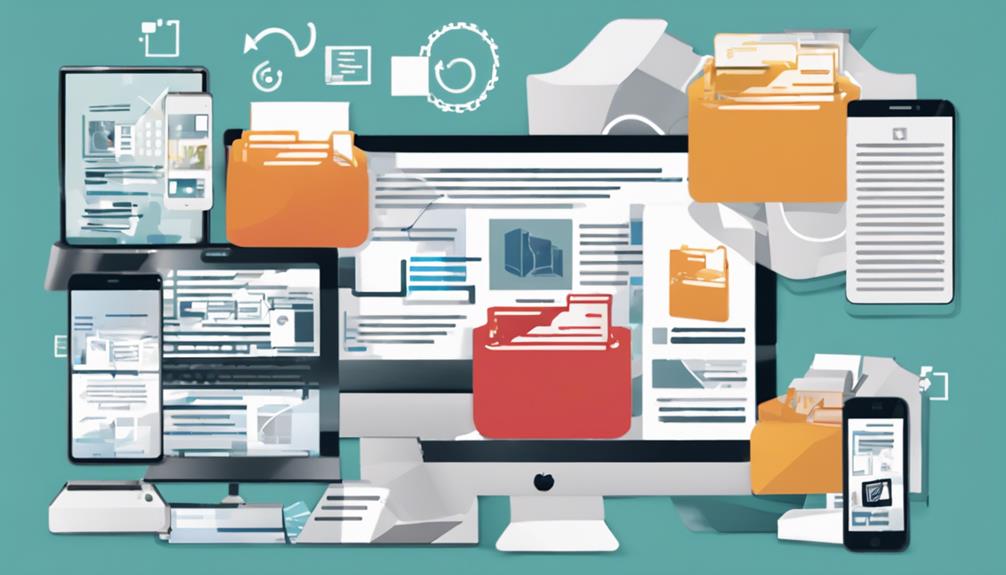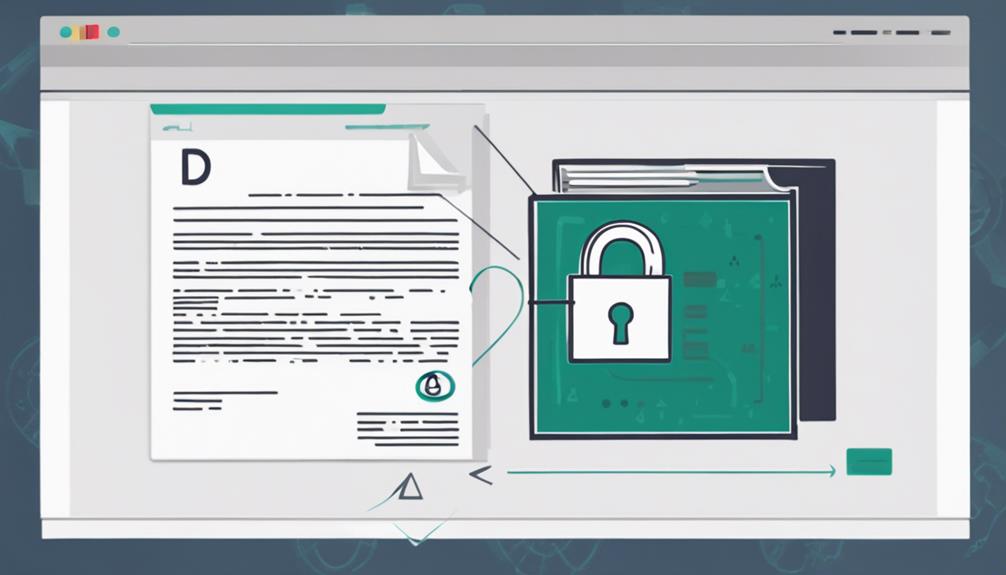You may question the accuracy of converting scanned documents. PDF conversion services convert scanned documents, and modern technology can handle this task seamlessly. However, have you ever pondered the potential challenges involved when dealing with handwritten notes or intricate layouts?
OCR Technology
When it comes to PDF conversion services and their ability to convert scanned documents, OCR technology plays a crucial role. OCR, Optical Character Recognition, is a technology that enables the conversion of different types of documents, including scanned images or PDFs, into editable and searchable data. This process involves text extraction from images or scanned documents, allowing for efficient document digitization.
OCR technology works by analyzing the shapes and patterns of characters in a document, translating them into machine-encoded text. This text extraction process is essential for accurately converting scanned documents into editable formats such as Word or Excel. Through OCR, PDF conversion services can ensure that the content of scanned documents is preserved during the conversion process, enabling seamless document digitization.
Image Quality
For PDF conversion services to effectively convert scanned documents, the quality of the images being processed is paramount. When it comes to image quality, resolution enhancement plays a crucial role. Higher resolution images provide more detail, making it easier for PDF conversion services to accurately interpret the text within the scanned documents. Image manipulation techniques such as noise reduction and contrast adjustments can further enhance the quality of scanned images, improving the overall conversion accuracy.
Resolution enhancement involves increasing the number of pixels in an image, resulting in sharper and clearer visuals. This process ensures that the text within scanned documents is accurately captured and converted into editable text. Image manipulation techniques like adjusting brightness and contrast can help improve the legibility of scanned text, especially in documents with poor lighting conditions or faded text.
Language Support
To ensure seamless and accurate conversion of scanned documents, the aspect of language support is crucial. Multilingual support is a key feature in PDF conversion services, allowing documents in various languages to be accurately processed. These services often include advanced language detection capabilities, which help identify the language of the scanned text and ensure accurate conversion. This is essential for maintaining the original content and formatting of the document during the conversion process.
Additionally, PDF conversion services with translation capabilities can further enhance language support by providing translated versions of the scanned documents. This is particularly useful when dealing with multilingual documents or when the final output needs to be in a different language. By integrating translation capabilities, these services offer a comprehensive solution for handling documents in different languages while maintaining language accuracy throughout the conversion process. Combining multilingual support, language accuracy, translation capabilities, and language detection ensures a high level of precision and efficiency in converting scanned documents.
Handwriting Recognition
When it comes to Handwriting Recognition, it’s crucial to consider the accuracy of the technology in deciphering various handwriting styles. OCR software capabilities play a significant role in determining the success of converting scanned handwritten documents into editable text. Understanding the intricacies of scanned document conversion is essential for achieving optimal results in converting handwritten content into digital formats.
Handwriting Recognition Accuracy
Achieving high handwriting recognition accuracy is crucial for the success of PDF conversion services. When it comes to handwriting recognition, accuracy assessment plays a key role in determining the effectiveness of the OCR software. Here are some important aspects to consider for improving handwriting recognition accuracy:
- Quality of Training Data: The accuracy of handwriting recognition heavily relies on the quality and diversity of the training data used to teach the OCR software to recognize different styles of handwriting.
- Feature Extraction Techniques: Utilizing advanced feature extraction techniques can significantly enhance the accuracy of handwriting recognition by capturing intricate details and patterns in the handwritten text.
- Machine Learning Algorithms: Implementing robust machine learning algorithms, such as deep learning models, can further improve the accuracy of handwriting recognition by enabling the OCR software to learn complex patterns and variations in handwriting styles.
OCR Software Capabilities
Enhancing the capabilities of OCR software to accurately recognize handwriting is a critical aspect of PDF conversion services. When dealing with handwritten documents, OCR software plays a pivotal role in converting them into editable text. OCR software is proficient in recognizing various file types, such as PDFs or image files, and extracting data from handwritten content. This process involves analyzing the shapes and patterns of handwritten characters to convert them into digital text.
OCR software employs sophisticated algorithms to interpret handwritten text, ensuring a high level of accuracy in the conversion process. By utilizing advanced machine learning techniques, OCR software continually improves its handwriting recognition capabilities. This allows for efficient data extraction from handwritten documents, enabling users to easily search, edit, and manipulate the converted text. The ability of OCR software to accurately decipher handwriting enhances the overall effectiveness of PDF conversion services, making them invaluable tools for digitizing handwritten content.
Scanned Document Conversion
To seamlessly transition into discussing scanned document conversion and handwriting recognition, it’s crucial to recognize the pivotal role that OCR software plays in digitizing handwritten content. When converting scanned documents with handwriting into digital formats, here are some key aspects to consider:
- Data Security: Ensure that the OCR software you use maintains high levels of data security to protect sensitive information during the conversion process.
- Quality Control: Implement quality control measures to verify the accuracy of the handwriting recognition and ensure that the converted text is error-free.
- File Format and Metadata Extraction: Choose the appropriate file format for the converted document, and utilize metadata extraction tools to retrieve valuable information embedded within the handwritten content.
Layout Preservation
Preserving the layout of scanned documents is crucial when utilizing PDF conversion services. The formatting accuracy and text extraction play a significant role in maintaining the design fidelity and content extraction of the original document. When converting scanned documents into PDF format, it is essential to ensure that the layout, including images, tables, and text, is accurately preserved.
PDF conversion services employ advanced optical character recognition (OCR) technology to extract text from scanned documents. This process ensures that the text is converted accurately and maintains its original formatting. Additionally, the design fidelity of the document is maintained through careful extraction of content such as headings, paragraphs, and lists.
Font Preservation
Maintaining the original fonts used in scanned documents is a critical aspect of font preservation during PDF conversion. When considering font preservation during PDF conversion services, there are key factors to keep in mind:
- Font Recognition: The PDF conversion service should utilize advanced OCR (Optical Character Recognition) technology to accurately identify and match the fonts used in the scanned document. This ensures that the converted PDF maintains the same visual integrity as the original.
- Text Conversion: Proper text conversion is essential for font preservation. The service must accurately convert the scanned text into editable text elements within the PDF while retaining the original font styles, sizes, and formatting.
- Quality Assurance: A meticulous quality assurance process is crucial to verify that the converted PDF accurately reflects the original document’s fonts. This involves thorough checks to ensure that all fonts are recognized correctly and displayed accurately in the final PDF output.
Frequently Asked Questions
Can PDF Conversion Services Convert Handwritten Text?
Yes, pdf conversion services can convert handwritten text. The OCR accuracy and handwriting recognition capabilities vary between providers. Ensure the service you choose has high accuracy levels to effectively convert handwritten text into editable digital documents.
Do PDF Conversion Services Support Non-Latin Languages?
Yes, PDF conversion services support non-Latin languages. They excel in language compatibility, OCR accuracy, font recognition, and character recognition. These features ensure accurate conversion of text in various languages, enhancing document readability and accessibility.
Will PDF Conversion Services Maintain Original Document Formatting?
Maintaining original document formatting is crucial. Most PDF conversion services excel in this area, ensuring image quality and accurate text recognition. You can trust that your scanned documents will be accurately converted without losing their layout.
Can PDF Conversion Services Extract Tables and Graphs Accurately?
When extracting tables and graphs, PDF conversion services rely on image recognition accuracy for precise data extraction. This ensures data visualization clarity, maintaining the original layout and design. Accuracy in image recognition is key for tables and graphs.
Are PDF Conversion Services Capable of Converting Low-Quality Scans?
When converting low-quality scans, ensure image enhancement to improve OCR accuracy. PDF conversion services can handle this task efficiently. They can transform imperfect scans into clear, searchable PDF documents, enhancing readability and usability.



